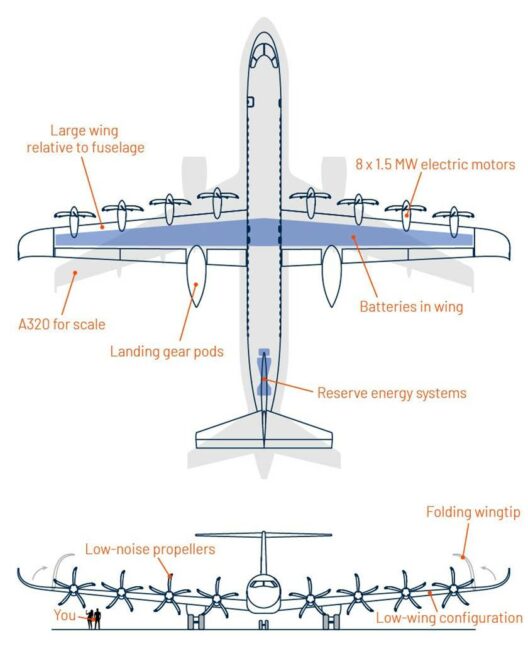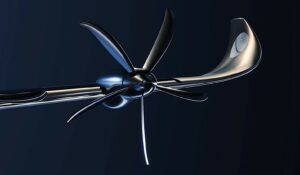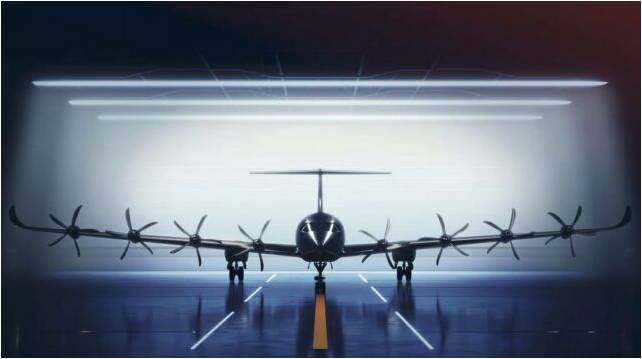What can carry 90 passenger 480 miles on battery power alone? Such a query flies in the face of others’ efforts to hybridize medium-range flight, but may be answered by Delft-based Elysian Aircraft. Their eight-motored, battery-powered E9X uses a backup turbogenerator only for reserves, putting a level of trust in the 365 Watt-hour per kilogram cells buried within the long, slender wing for safe transit.

E9X dimensions mirror that of A320, but design philosophy is unique
Graham Warwick’s Article
Graham Warwick, writing for Aviationweek.com, explains that, “Breaking with traditional design principles, Delft-based Elysian says it has found design space where a large electric aircraft looks viable with near-term battery technology.” That kind of range for that large an aircraft seems extreme, but the E9X’s developers are using currently-available batteries to achieve their goals. Reynard de Vries, director of design and engineering at Elysian, explains, “If you want to make a significant impact on the sector as a whole, then you need to electrify flights up to 1,000 km [620 mi.]. Then you’re talking about roughly one-fifth of aviation emissions and about half of all passenger flights.”
He continues, “We found design space where we believe that, with the right design, a battery-electric aircraft can fly much farther than most studies suggest and also carry many more passengers.” It’s not crazy, hocus-pocus science, new technology or complex materials or anything like that. It’s looking in the right corner of the design space.” Reynard holds forth in this video, possible made during his stay in Orlando.
This kind of thinking has enabled breakthroughs using available materials. Eric Raymond, for instance, flew across the United States in 21 hops in 1990 on NiCAD batteries and five-percent efficient solar cells. He added an ultralight, 45-foot span airframe that weighed a mere 98 pounds and a propulsion system developed with Allen Cocconi.
Rethinking Batteries
Such rethinking of what can be done within existing constraints enables opening new possibilities. Studies performed by Delft Technical University suggest radically different views of what most think can be achieved with battery-powered craft. Both studies were presented to the AIAA by the authors, Rob E. Wolleswinkel, Reynard de Vries, Maurice Hoogreef and Roelof Vos at the AIAA SCITECH 2024 Forum held in early January in Orlando, Florida. All are members of the e9X team and teachers or students at Delft Technical University.
A first study redefines “new parametric designs for an electric aircraft suitable for 40 to 120 passengers,” and “presenting design principles that enable a much higher range than previously thought possible.”
The second study “presents a conceptual design of a battery-electric 90-seater aircraft, which includes: batteries integrated into the wings, a low-wing configuration, and folding wingtips.”
Such an aircraft could flu 500 miles on “near-term” batteries. In fact, the 360-Watt-hours-per-kilogram cells premised in the studies already exist and are being exceeded. The craft would have a maximum take-off weight (MTOW) around that of an Airbus A320. As with all battery-powered electric craft, that is also the maximum landing weight – unlike an A320, which burns off its fuel during flight.

E9X wingtips fold, eight 1.5 mW motors driving 3.7-meter (12.14 feet) propellers provide thrust
Distributing thrust across 36 meters (118 feet) of the E9X’s 42-meter (137.8 feet) span probably helps reduce takeoff roll and increase rate of climb. The low wing would probably decrease takeoff and landing speeds because of enhanced ground effect. It also allows use of a shorter, lighter weight landing gear, tucked neatly into streamlined pods on the trailing edge. Batteries distributed along the span mid-wing reduce bending moments. Folding wing tips are necessary to enable parking in A320-sized spaces on jetways.
Better than Sustainable Aviation Fuel?
Contrary to those groups exploring hydrogen in fuel cell or direct fuel form, or hybrid drive systems, the Delft team looked at batteries, especially those available now. Amprius can supply a cell that more than meets the 360 Watt-hours per kilowatt design requirements, and planned improvements could further increase the craft’s range. To eliminate the added weight of batteries to meet reserve requirements, the team uses a small turbogenerator in the tail and a small amount of fuel. This is apparently a lighter overall solution than additional batteries.
Elysian claims “up to five times higher efficiency per passenger kilometer than hydrogen or SAF-powered aircraft, matching the energy efficiency of an average electric car with 1.2 passengers.”
Fokker Services supports the Fokker fleet worldwide but also has developed supplemental type certificates for older aircraft. Panta, part of Fokker Holdings, founded Elysian and committed €4 million ($4.4 million) to the project. Daniel Rosen Jacobson, Elysian co-CEO and chief business officer and director for aerospace and technology at Panta, explains how Panta brought in a French investor. “They invested an amount based on milestones.” Such milestones probably include design, creation of scale models for proof of concept validation, and development of full-scale prototype.
Elysian’s E9X will probably enter the market later than hydrogen and hybrid aircraft being developed by others, but could be a formidable rival in a surprising approach to short and medium range clean aviation.
Read the Aviation Week article for a full recounting of Elysian’s efforts. This article is published in Aviation Week & Space Technology and is free to read until Feb 10, 2024. If you want to read more articles from this publication, please click the link to subscribe.

